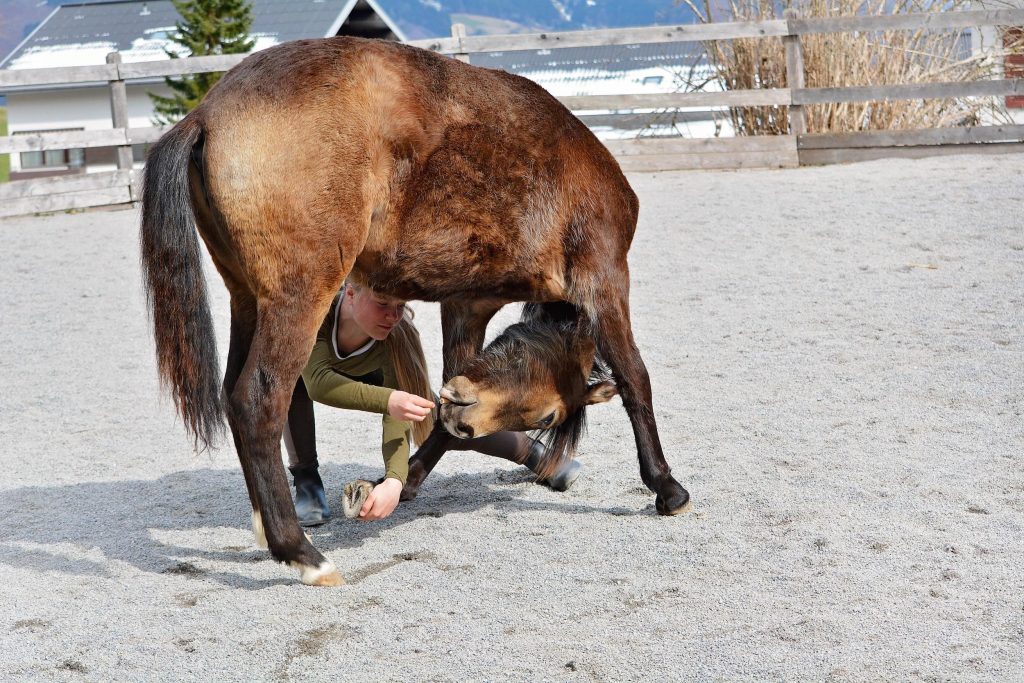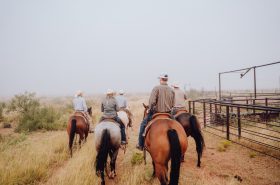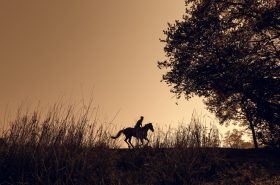Positive reinforcement has proven effective in horse training.
Clicker training with horses is a unique form of training that uses a reward to encourage positive behavior. In many cases, treats or hay pallets are used by the trainer in a pouch. Some use scratches, especially for younger horses who really enjoy them. A clicker or unique sound is necessary during training. This form of horsemanship is very powerful! It also allows you to build a meaningful relationship with your horse.
Types of Clicker Training with Horses
In horse training, there are four main ways to motivate or shape behavior. Some trainers will only use one form, while most will use a combination of two. It’s important to experiment and see what works best for you and your horse.
- Positive Reinforcement: Add a desirable stimulus, like a treat, to encourage the behavior.
- Negative Reinforcement: Remove something to encourage the behavior. Example: Release of pressure.
- Positive Punishment: Add something, such as a crop, to shape behavior.
- Negative Punishment: Take away something to discourage the behavior. Example: Removing the treats if the horse pushes into you.
Many horse trainers use pressure and release methods. It can be a great idea to include positive reinforcement with traditional horsemanship.
Getting Started
One of the most important tools in clicker training is the “clicker”. It allows the horse to understand they’ve done something good. Some trainers may use a whistle or cluck of their tongue. Generally, beginners find it easier to use a clicker tool.
In the beginning, you’ll need to convince your horse the clicker is a good thing. You want them to seek the sound! This is done by clicking and immediately feeding your horse a treat several times in a row. The treat can be alfalfa pellets, a sugar cube, or pieces of a carrot. It’ll depend on if your horse is on a low-sugar diet. The treats should be easy to reach, as timing is everything!
It’s better to keep your sessions short. Start with two or three sessions and only 10-12 treats. Click and reward, click and reward until you run out of treats. Eventually, your horse will learn that this click sound indicates a treat is coming. For pushy horses, you may want to start with a barrier like a stall door or fence. Some of them get very excited.
Shaping Behavior
Once your horse understands the clicker, most are willing to do just about anything to get a reward. Horses are very food motivated! Most trainers will then teach their horse to touch and follow a target. Some use a boat buoy with a handler, while others make their own out of a stick and tennis ball.
To shape the behavior, you patiently wait for the horse to touch the target on their own. You reward any effort even when their nose heads in the right direction. In the beginning, the reward should be big. Once they frequently do the behavior you can minimize the number of treats.
There’s plenty more you can teach your horse once they understand the signal to touch a target. You can have them follow one into a horse trailer, touch a stationary one in their stall while you dump their grain, and even teach them how to lunge around you. The options are endless!
Many clicker trainers take basic skills and turn them into tricks! They may teach their horse to bow, shake their head ‘yes’, or leg yield down the wall. Some train their horse under saddle with the clicker.
If you’re interested in learning more about clicker training with horses, then I recommend checking out The Willing Equine, Shawna Karrasch’s podcast, or joining a positive reinforcement Facebook group. There are tons of available resources to get you started!
Love this blog post? We think you will like Acceptance From Horses by Chris Cervantes.




